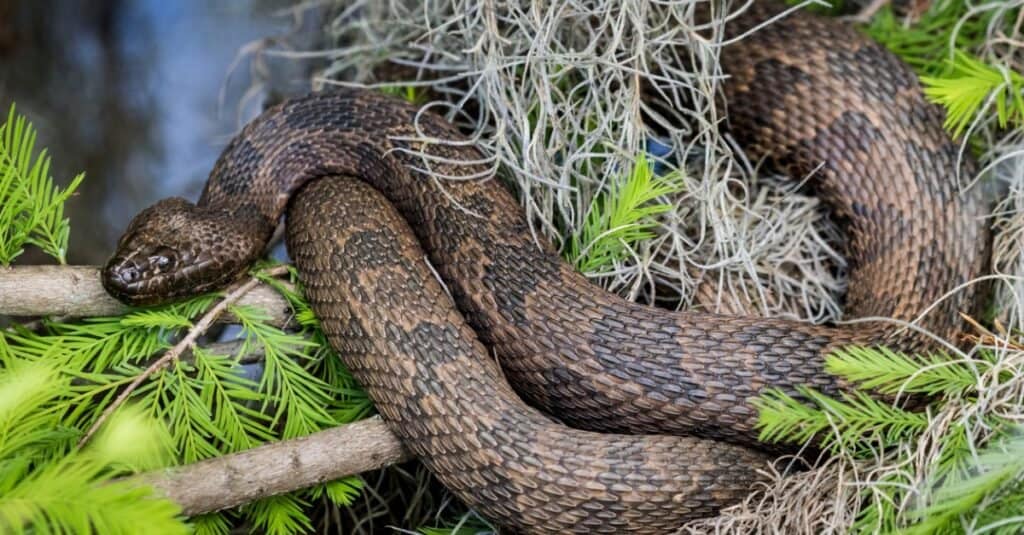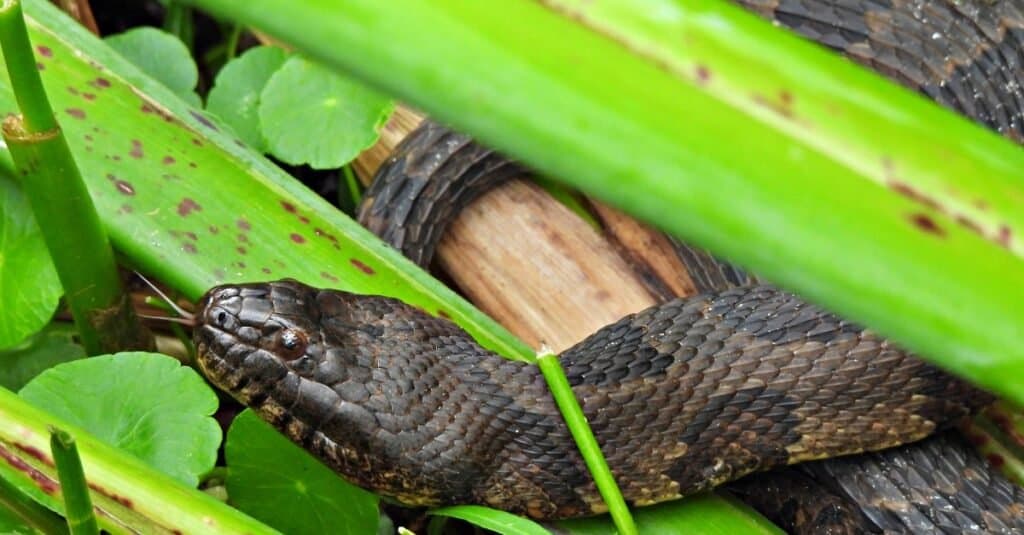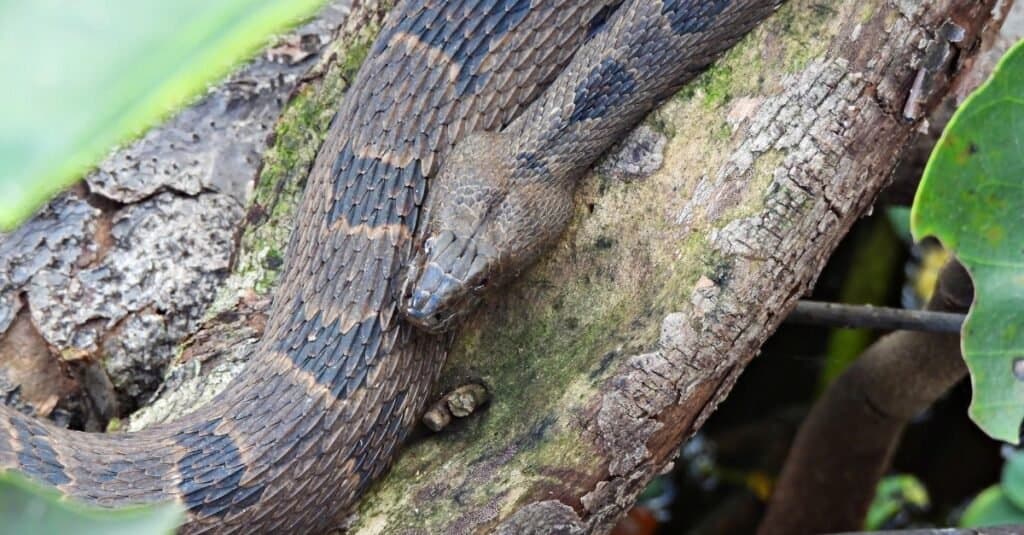Brown Water Snake
.jumbotron {
background-image: url(“https://a-z-animals.com/media/2022/01/brown-watersnake2-400×300.jpg”);
}
}
@media only screen and (min-width: 641px) and (max-width: 920px) {
.jumbotron {
background-image: url(“https://a-z-animals.com/media/2022/01/brown-watersnake2-470×370.jpg”);
}
}
@media only screen and (min-width: 921px) {
.jumbotron {
background-image: url(“https://a-z-animals.com/media/2022/01/brown-watersnake2.jpg”);
}
}
Brown Water Snake
Nerodia taxispilota
Brown Water Snake Scientific Classification
- Kingdom
- Animalia
- Phylum
- Chordata
- Class
- Reptilia
- Order
- Squamata
- Family
- Colubridae
- Genus
- Nerodia
- Scientific Name
- Nerodia taxispilota
Read our Complete Guide to Classification of Animals.
Brown Water Snake Conservation Status
Brown Water Snake Facts
- Prey
- fish
- Other Name(s)
- water rattle, southern water snake, pied water snake, greater water snake, water-pilot, aspic, and false moccasin
- Litter Size
- Up to 61, but typically 20-30
This post may contain affiliate links to our partners like Chewy, Amazon, and others. Purchasing through these helps us further the A-Z Animals mission to educate about the world’s species..

Discover alligator-eating snakes, spiders larger than your phone, and 1000 more incredible animals in our daily FREE email.
.photo-gallery {
–margin: 0px auto 0px;
–padding: 0px 0px 0px 0px;
}
.gallery-link {
background-image: url(“https://a-z-animals.com/media/2022/01/brown-watersnake-1024×535.jpg”);
background-repeat: no-repeat;
background-size: cover;
background-position: center;
height: 500px;
justify-content: center;
text-align: center;
align-items: center;
display: flex;
border: 2px solid #000;
}
.gallery-link img {
height: 50%;
}
@media only screen and (max-width: 768px) {
.gallery-link {
height: 300px !important;
}
}
View all of the Brown Water Snake images!
“Brown water snakes are commonly seen with the spines of catfish they’ve eaten sticking out of their sides!”
Brown water snakes are aquatic snakes from North America that feed primarily on fish. Brown snakes are commonly seen with the spines of catfish they’ve eaten sticking out of their sides! They typically recover from these injuries. These snakes are nonvenomous and not aggressive, but they can be mistaken for the poisonous cottonmouth.
4 Incredible Brown Water Snake Facts!
- They take on a dangerous prey — catfish that have sharp spines. These spines may pierce the snake after the fish is swallowed, but the snake usually survives and recovers.
- They fall out of trees into the water when startled.
- They hunt by scent rather than by visually tracking movement.
- They release a smelly musk when frightened.
Where To Find Brown Water Snakes
Brown water snakes are endemic or native to southeastern North America. This includes the states of Alabama, Florida, Georgia, Louisiana, Mississippi, Missouri, North Carolina, South Carolina, and Virginia.
button.pulse {
transform: scale(1); animation: pulse 2s infinite;
box-shadow: 0 0 0 0 rgba(11, 247, 25, 1);
}
@keyframes pulse {
0% { transform: scale(0.90); box-shadow: 0 0 0 0 rgba(11, 247, 25, 0.5); }
60% { transform: scale(1); box-shadow: 0 0 0 15px rgba(11, 247, 25, 0); }
100% { transform: scale(0.90); box-shadow: 0 0 0 0 rgba(11, 247, 25, 0); }
}
Brown watersnakes are typically found at elevations ranging from sea level to 500 feet. Their habitat and location consist of streams, swamps, and other wet areas. They must have an aquatic habitat since their primary food source is a diet of fish.
Scientific Name
The brown water snake, also spelled watersnake, has the scientific name Nerodia taxispilota. It was first described scientifically in 1842 by the American zoologist and herpetologist John Holbrook, who then called the species Tropidonotus taxispilotus, assigning it to a different genus. In 1889, zoologist Edward Cope gave it the identification Natrix taxispilota. The brown watersnake received its current scientific identification in 1991. It is part of the family Colubridae and class Reptilia, a reptile.
Other common names for the brown watersnake include water rattle, the southern water snake, the pied water snake, the greater water snake, the water-pilot, the aspic, and the false moccasin.
Sometimes, the common name “brown water snake” is also applied to the species Lycodonomorphus rufulus. These two species should not be confused in identification, as L. rufulus is native to South Africa.
Population & Conservation Status
The brown watersnake is common or of least concern throughout its habitat. It is not protected in much of its range, but there are areas in which killing the brown water snake is illegal, including the state of Georgia.
Appearance and Description
These snakes have a thick, heavy body that is light brown with darker brown rectangular patches. The patches on the back are larger than those on the sides, and back and side patches are usually not connected. They have a broad, triangle-shaped head with a distinctly narrower neck for its size. For this reason, it is sometimes misidentified as a venomous snake.
Brown water snakes have keeled scales. This means that the scales are not smooth but have a ridge down the center. It has more scales than any other water snake on the continent — 27 to 33 rows of dorsal scales. It also has two to four anterior temporal scales behind the eyes, whereas most other snakes have only one.
Brown water snakes are typically 3.5 to five feet in length. The record size is nearly six feet in length at 69 inches.
Baby snakes are smaller than adult reptiles but the baby’s colors are the same as the adults’ colors. This makes the identification of the baby easier.
How to Identify a brown water snake:
- Brown base color with darker brown rectangular patches
- Large patches on the back, smaller patches on the sides
- Heavy body with a broad, triangular head
- Eyes set toward the top of the head
- Yellow or cream colored belly
Brown Water Snake vs Cottonmouth
Cottonmouths and brown water snakes are often confused because of the similar range, habitat location, colors, body, and head shape.
In the American South, it is often repeated that venomous snakes have triangle-shaped heads. These are facts of the rattlesnakes, cottonmouths, and copperheads that live in that location, but it is also true of nonvenomous species like the brown water snake. Sadly, this results in people killing water snakes, thinking they are dangerous.
There are a few subtle differences to look for to tell these snakes apart. Cottonmouths are pit vipers; they have heat-sensing pits between the eye and nostril. Water snakes lack these pits.
Additionally, cottonmouths have a distinctive bright white coloration inside their mouths – hence the name. The white inner lining of the mouth can be seen when the snake is agitated and poised to strike. Brown water snakes have dark-colored mouths.
The pupils of the reptile’s eyes are also slightly different, with the watersnake’s being rounder.
Pictures

iStock.com/csraphotography

iStock.com/passion4nature

iStock.com/passion4nature
Venom: How Dangerous Are They?
Brown water snakes have no venom. When threatened, they are likely to flee. However, these snakes are predators and will bite if cornered. Though not venomous, snake bites can become infected and require medical care.
Behavior and Humans
These snakes are shy and are likely to flee if approached by a human. They often rest on tree branches overhanging a body of water. They can make a quick getaway by falling into the water if disturbed.
If cornered or captured, brown water snakes will coil, hiss, strike, and attempt to bite. They also release a smelly musk when frightened.
Humans are a much larger threat to these predators than they are to us. Each year, many of these snakes are needlessly killed because they are mistaken for venomous water snakes. Some are killed simply because some people are afraid of all snakes, regardless of the species.
View all 192 animals that start with B
Brown Water Snake FAQs (Frequently Asked Questions)
Are brown water snakes venomous?
No, brown water snakes do not have hollow fangs to deliver a venomous bite or glands that produce venom. They are predators, however, and have many sharp, small teeth and can deliver a painful bite if they feel threatened.
How do brown water snakes hunt?
Brown water snakes live in an aquatic environment and hunt fish. They may sit still with their mouths open, waiting for prey to swim by.
Are brown water snakes aggressive?
They are not generally aggressive but will bite if threatened.
Where do brown water snakes live?
The range of the brown water snake spans the southeastern United States. They live in swamps, creeks, and other bodies of water.
What do brown water snakes eat?
Brown water snakes eat fish; catfish are their favorite prey. Sometimes they will also eat amphibians, invertebrates, or small mammals.
What does a brown water snake look like?
Brown water snakes are thick-bodied with a distinct triangle-shaped head. They are light brown with darker brown rectangular patches.
How long will an Eastern brown water snake live?
Water snakes have a lifespan of more than 9 years in captivity. The exact lifespan of the brown water snake in the wild is unknown, though it is probably less than in captivity.
Are brown water snakes poisonous?
No, brown watersnakes are not poisonous or venomous. Biologically speaking, venomous animals have a toxic bite or sting, whereas poisonous animals are toxic when eaten.
They are sometimes mistaken for venomous water snakes like cottonmouth or water moccasin.
Are brown water snakes good pets?
In many areas, it is illegal to catch and keep native snakes as pets. Though not considered an aggressive species, water snakes will become aggressive and defend themselves by coiling, hissing, and biting.
If you obtain a brown water snake legally from a reputable pet dealer, water snakes can be successfully cared for in a home aquarium. They do not require special lighting and can withstand cooler temperatures than some other snake species. They can become accustomed to being gently handled.
Captive water snakes should be fed a diet of live fish placed in the aquatic portion of their aquarium. Since water snakes hunt by smell and not by sight, they are unlikely to bite your fingers, mistaking them for food.
What are the differences between brown water snakes and cottonmouths?
The differences between brown water snakes and cottonmouths are their appearance, preferred habitat, behavior, diet, and relative danger.
Sources
- Wikipedia, Available here: https://en.wikipedia.org/wiki/Brown_water_snake
- Savannah River Ecology Laboratory: UGA, Available here: https://srelherp.uga.edu/snakes/nertax.htm
















